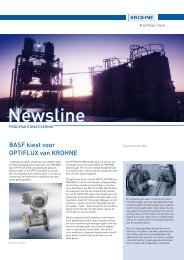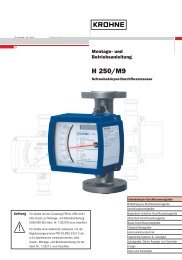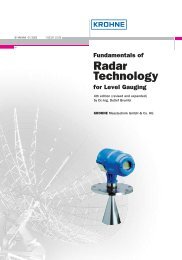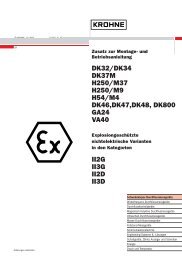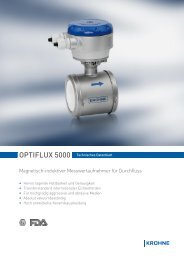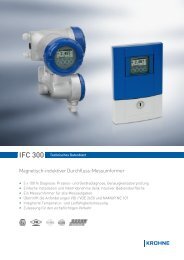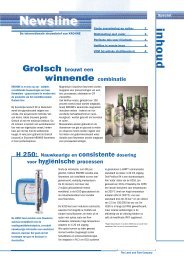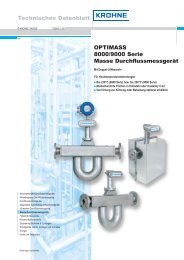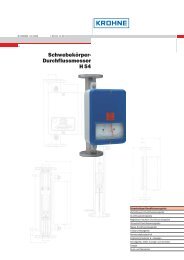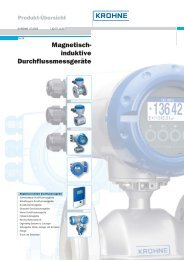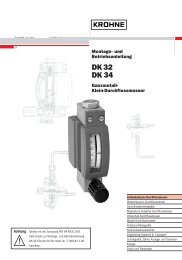Measurement Automation Strategy: Key to Bio-Ethanol ... - Krohne
Measurement Automation Strategy: Key to Bio-Ethanol ... - Krohne
Measurement Automation Strategy: Key to Bio-Ethanol ... - Krohne
Create successful ePaper yourself
Turn your PDF publications into a flip-book with our unique Google optimized e-Paper software.
KROHNE White Paper <strong>Measurement</strong> <strong>Au<strong>to</strong>mation</strong> <strong>Strategy</strong> <strong>Key</strong> <strong>to</strong> <strong>Bio</strong>-<strong>Ethanol</strong> Refinery Efficiency<br />
By Hemant Narayan<br />
cellulosic. The goal of the<br />
rectification process is <strong>to</strong> achieve<br />
maximum purification (up <strong>to</strong> 190<br />
proof). Then the dehydration<br />
process employs molecular<br />
sieves <strong>to</strong> convert the 190 proof<br />
ethanol in<strong>to</strong> 200 proof ethanol,<br />
going from 5% moisture content<br />
<strong>to</strong> 0%.<br />
If the process fluid moves <strong>to</strong>o<br />
quickly through the molecular<br />
sieves and some moisture<br />
remains, then the entire batch<br />
must be run back through the<br />
dehydration system again – a<br />
completely inefficient step that<br />
wastes energy and ties up<br />
production capacity and<br />
potentially causes a bottleneck<br />
for the entire plant. To avoid this<br />
problem, a plant could extend<br />
the dwell time in the molecular<br />
sieves <strong>to</strong> ensure that all<br />
moisture is removed. However,<br />
this margin of comfort comes at<br />
a cost in terms of productivity<br />
loss and unnecessary energy<br />
consumption.<br />
Alcohol proof measurement of<br />
rectifier output (190 proof) and<br />
dehydration output (200 proof)<br />
can dramatically improve<br />
process efficiency. Precise<br />
density measurements, detects<br />
exactly when the ethanol reaches<br />
the anhydrous threshold (zero<br />
moisture content), so that the<br />
dehydration process can meet its<br />
target without overreaching,<br />
thereby obviating the need for<br />
any wasteful comfort margin.<br />
As with the percent-solids<br />
measurement application discussed<br />
above, the new generation of Coriolis<br />
meters with single, straight tube<br />
design, has proven <strong>to</strong> be a highly<br />
accurate and reliable solution for realtime<br />
moni<strong>to</strong>ring of alcohol proof during<br />
the rectification and dehydration<br />
processes. The continuous trends data<br />
allows for instantaneous correction of<br />
process upsets and ensures the<br />
consistent and tight control of proof<br />
values in final product. This process<br />
control is critical <strong>to</strong> meeting quality<br />
control specifications and <strong>to</strong> increasing<br />
throughput and profitability.<br />
An important advantage of the state-ofthe-art<br />
Coriolis meters, such as the<br />
KROHNE 7000 Series T80 OPTIMASS<br />
meter, is the ability <strong>to</strong> measure<br />
multiple parameters in a single device –<br />
proof, density, temperature and flow.<br />
Previously, plant opera<strong>to</strong>rs needed <strong>to</strong><br />
purchase, install, calibrate and<br />
maintain several separate devices <strong>to</strong><br />
perform all these functions: typically<br />
one meter would measure density and<br />
proof on a slipstream, and additional<br />
instruments would be installed in the<br />
main line <strong>to</strong> measure temperature and<br />
flow.<br />
More Efficient Dryer Operation<br />
Single straight tube Coriolis meters,<br />
with multiple-parameter capability,<br />
also provide high pay backs when<br />
installed on the evapora<strong>to</strong>r syrup draw.<br />
Installations of an online flow/density<br />
meter at the intermediate and final<br />
stages of the evapora<strong>to</strong>r process have<br />
successfully demonstrated significant<br />
reductions in energy consumption, by<br />
February 20, 2008 8 of 12




